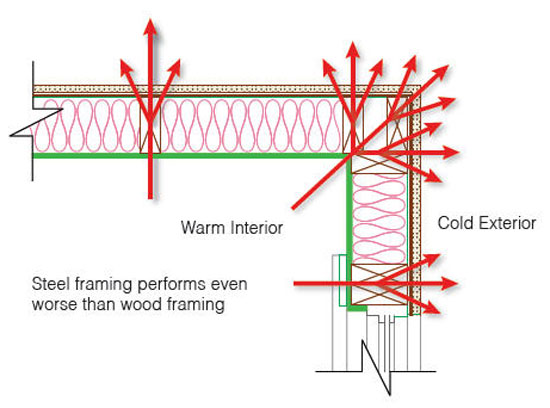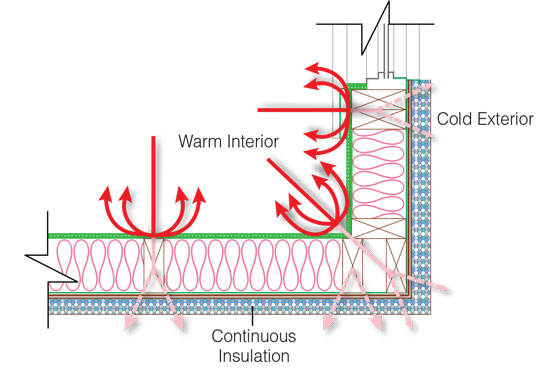EIFS - Performance Beyond Code Compliance
Conventional Exterior Walls: Performance Issues
Meeting each of the various code and performance requirements for exterior walls has commonly meant addressing them each individually. Therefore, the very common framed cavity walls using metal studs in commercial buildings (either as direct structural support or as infill between structural steel or concrete) are typically detailed and constructed with different layers of materials. While this is logical and would seem to allow for a reasonable degree of quality control, the reality is that this process has some inherent material limitations and compatibilities that can cause compromises on the actual performance, and code compliance, of the wall.
First, as we have already seen, the use of metal studs provides a dramatic reduction in the effectiveness of non-ci when it is interrupted by studs. But thermal bridging occurs at other locations as well. This is particularly evident on multi-story buildings where a stud wall assembly is used on multiple floors. The studs commonly rest on and get anchored to a floor structure that for example could be 4 to 6 inches of concrete in a metal deck or a 10-inch to 12-inch wood framed structure. In this type of construction, the insulation in the wall studs stops above and below the floor structure meaning the floor edge is exposed along the full length and width of the building. It is therefore a very significant thermal bridge since there is nothing to prevent heat from being transferred between the inside and the outside of the building along the entire perimeter of the floor construction.
Significant thermal bridging can also occur around structural elements such as columns or beams made of steel or concrete if they are not insulated on the outside. Stud framing is often set between these structural elements to create a smooth interior wall surface. However, that means that the insulation stops where the studs stop, essentially leaving a gaping interruption of the insulation. Hence the code requires ci be provided to address this problem and defines it as insulation that is continuous across all structural members without thermal bridges other than fasteners and service openings. It is installed on the interior, exterior or is integral to any opaque surface of the building envelope.
 |
 |
Exterior continuous insulation effectively stops thermal bridging found in conventional metal stud wall. Images courtesy of Dryvit Systems, Inc. |
The most popular place to add this ci is on the outside face of the exterior wall sheathing. All by itself, this is the best way to improve energy performance which is clearly the desirable outcome. But the practicality of doing so presents itself as an issue when detailing the entire wall assembly from the interior face to the exterior face including the cladding that will go over the ci. Continuous insulation mounted on the exterior moves traditional claddings further out from the wall meaning that it is essentially cantilevered further off the structural line. This increases moment stresses at points of anchoring and bearing and needs to be addressed, usually by increasing the size of lintels, attachment members and foundations thus adding to the cost. It also makes the total wall assembly thicker which will impact the detailing of window and door openings including the sizing of frames for all of them. In the end, it will be required to address all of these items, but the reality is that it is extra work both in design and construction to be sure that all systems are working together properly and staying within budget and schedule.
Conventional construction limitations apply to the development of a continuous air barrier too. Vapor and air barriers that are installed in sheets or rolls certainly work well at their center but they will have seams along their edges. Further they need to be integrated into the transition areas where walls join together, where they meet other surfaces such as floors and roofs, and where they meet openings such as doors and windows. All of these locations are potential breaches or interruptions in the barrier that need to be overcome or detailed away. In looking at how those details are handled, issues of NFPA 285 compliance may come into play to be sure that the total wall system will still pass the fire testing requirements of the code. In particular, commercial building walls above 40 feet in height are required by the IBC 2012 to have water-resistive barriers that are NFPA 285 compliant. This provision will also apply to the continuous air barrier where it is integrated into a combined air/ water-resistive barrier. If the wall construction does not match a previously tested was assembly, then a test will need to be performed for the particular assembly designed for the project which will of course add cost and time to the project.









